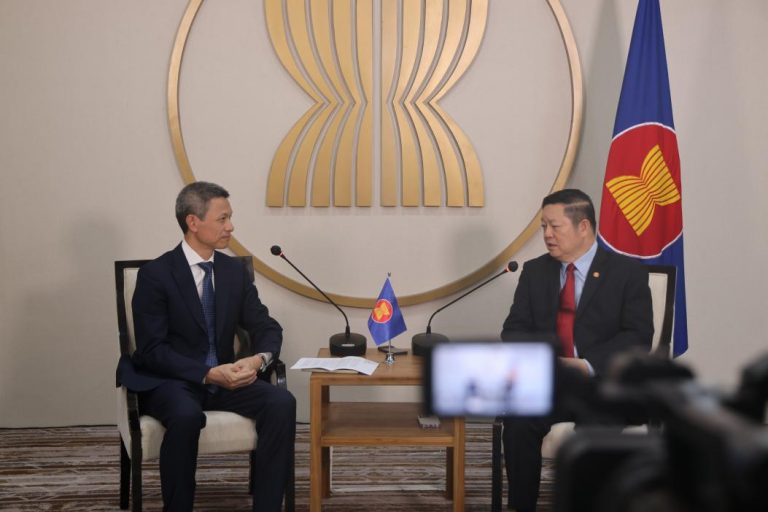
By Zhang Niansheng, Zhang Jinruo, People’s Daily
“My trip to China was an eye-opening trip to me,” Kao Kim Hourn, 15th Secretary-General of the Association of Southeast Asian Nations (ASEAN), told People’s Daily at the ASEAN Secretariat in Jakarta, Indonesia, in an interview on June 17.
“I found it very interesting that China has dedicated many resources to research and innovation to the government.”
These are the areas that ASEAN could learn a bit from China, particularly research, innovation and technology, and other areas.
Kao took office in January. In March, Kao participated in the Boao Forum for Asia Annual Conference for the first time as secretary-general of the 10-member regional political and economic union.
“The Boao Forum for Asia is an essential multilateral cooperation platform in Asia, which can not only help ASEAN countries strengthen cooperation but also enable ASEAN to deepen ties with other Asian countries, including China,” Kao said.
China was Kao’s first ASEAN Dialogue Partner country to visit after he took office.
He visited six Chinese cities in six days, met heavyweight government officials, took the high-speed rail, gave speeches at universities, and saw companies and the production workshop of BYD Auto.
He said that at the 42nd ASEAN Summit, which ended in May, it was emphasized that ASEAN member states need to pay attention to protecting their ecosystems.
“We welcome more Chinese new energy car companies to invest and build factories in ASEAN member states, which is also in line with our development direction from fossil energy to clean energy,” he said.
This year marks the 10th anniversary of China’s proposal to build a closer China-ASEAN community with a shared future. Also, it marks the 20th anniversary of China becoming the first country outside ASEAN to join the Treaty of Amity and Cooperation in Southeast Asia, which has many commonalities with the Global Security Initiative that China put forward last year.
Kao said that China had kept its promises over the past 20 years, actively supported regional peace, stability, and security, and contributed outstandingly to promoting regional development and prosperity.
China has been ASEAN’s largest trading partner for 13 consecutive years since 2009.
He said implementing the Regional Comprehensive Economic Partnership has helped accelerate China-ASEAN economic and trade cooperation.
Version 3.0 China-ASEAN free trade agreement negotiations are also advancing this year, Kao said. “ASEAN and China have broad prospects for in-depth cooperation in the fields of trade and investment,” he said.
The year 2023 marks the 10th anniversary of China’s Belt and Road Initiative.
Kao said the United Nations issued a report stating that the Belt and Road Initiative was “essential” in realizing the UN 2030 sustainable development goals.
“The joint construction of the Belt and Road has also made important contributions to the improvement of the infrastructure of ASEAN and strengthened the connectivity of its member states,” he said.
“The Phnom Penh-Sihanoukville Expressway connecting Cambodia’s capital and Sihanoukville, the first expressway built in my hometown Cambodia, is a key project of the China-Cambodia joint construction of the Belt and Road Initiative, which saves the commuting time of the local people,” Kao said.
He also highlighted the Jakarta-Bandung High-speed Railway and China-Laos Railway.
“It is an important contribution, on the one hand, to the ASEAN community building,” he said.
“On the other hand, of course, to the strengthening of us in China partnership and connectivity as well.”
“All of these projects benefit the people of ASEAN.”
Kao said China’s annual economic growth target is about 5 percent.
“With China’s full reopening to the world, it will not be difficult to achieve this goal,” he said. “I’ve noticed that the number of tourists in China has soared during the recent holidays, which can stimulate China’s domestic economic growth.”
“At the same time, China’s reopening to the world means Chinese tourists will return, which will also positively promote the region’s economic development, particularly for ASEAN. “
The population of ASEAN is expected to peak in 2030. The population of people aged 60 or older in ASEAN countries has exceeded 70 million.
Kao said he believed the treatment of older people reflects a society’s civilization.
“China has a huge elderly population,” he said. “China attaches great importance to the health protection and emotional care of their elderly population.”
“The two sides can share specific practices and policy experiences to better cope with the future ongoing challenge of population aging.”










